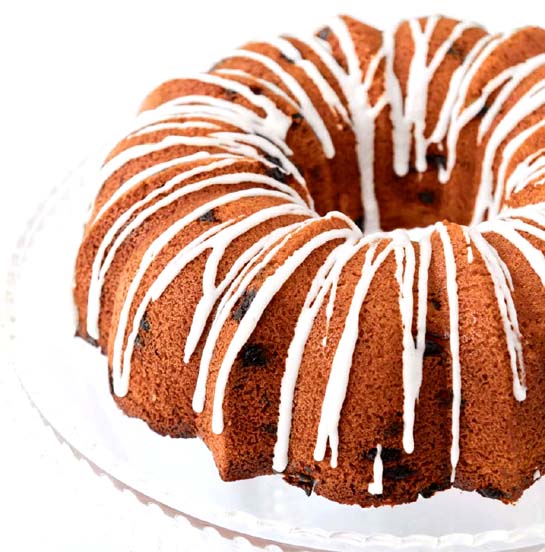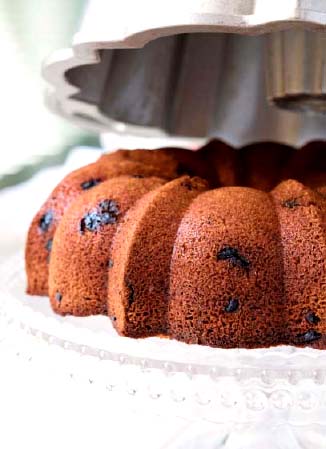
This is an unassuming cake in the looks department, but you’ll definitely be going back for more! The crunchy seeds of the passionfruit are lovely, but if you’d prefer your cake without them simply push the pulp of the passionfruit through a sieve and discard the seeds.
Makes one 25cm (10in) Bundt cake
Prep: 25 minutes plus cooling
Bake: 35 minutes
Oven: 160°c (fan)/180°c/350°F/Gas Mark 4
250g (9oz) very soft butter
265g (91⁄2oz) caster (superfine) sugar
4 eggs, large
200g (7oz) self-raising (-rising) flour
Pulp from 2 large passionfruit, approx. 80g (3oz) each
100g (31⁄2oz) creamed coconut, finely grated
140ml (41⁄2fl oz) coconut cream
50g (13⁄4oz) icing (confectioners) sugar, sifted
2 tsp coconut cream
2.4 l (12 cup) Bundt tin (Bundt pan)
Electric hand-held whisk or food mixer
Disposable plastic piping bag

1 Preheat the oven to 160°C(fan)/ 180°C/350°F/Gas Mark 4. Prepare the tin: grease it well, including the ring in the centre and all the other little nooks and crannies.
Cake release spray is a handy little helper when it comes to tricky shaped tins that can’t be lined with paper. A good generous spray takes the hard work out of greasing tins.
2 Cream together the butter and sugar until pale and fluffy using an electric whisk or food mixer.
3 Beat the eggs together in a separate jug. Add the beaten eggs a tiny little bit at a time to the butter and sugar mixture, beating in well after each addition.
4 Add the flour to the bowl and fold through using a spatula or metal spoon. Scrape the pulp from the passionfruit and add to the bowl, along with the finely grated creamed coconut and the coconut cream. Fold through until evenly distributed through out the mixture.

5 Fill the prepared Bundt tin with the mixture, dolloping it into the base of the tin to form a ring. Gently smooth over the surface with the back of a spoon so it sits evenly.

This recipe will fit into a smaller 2.1l (9 cup) Bundt tin if you prefer – you’ll just have a slightly taller cake!
6 Bake in the preheated oven for 35 minutes. Insert a metal skewer through a crack in the top of the cake to see if it’s done – it should come out clean or with just a few moist crumbs. If there is still cake mixture clinging to it bob it back into the oven and check at five-minute intervals until cooked all the way through.
7 Once baked you need to negotiate getting it out of the tin in one piece. First up let it cool, in the tin, for 30 minutes. This allows the structure of the cake to firm up – flip it out straight from the oven and it’ll come out in bits! Once you’ve let it cool take a plate and place it over the top of the tin, and in one swift movement flip it over. The cake should drop down directly onto the plate. Remove the tin and allow the cake to cool down fully.

8 Sift the icing sugar into a bowl and add 2 teaspoons of coconut cream. Mix it up to a fairly stiff icing – it should be the same consistency as a thick custard. If it’s too thick add a little water but only a tiny bit at a time. Fill the piping bag with the coconut icing and set to one side.
9 Transfer the cake carefully to a serving plate. Taking a long strip of cling film (plastic wrap), wrap it around the edge of the plate tucking it neatly against the bottom edge of the cake. This will stop the plate being covered in flicks of icing. Snip the end off the piping bag and drizzle the icing all the way round the cake. Remove the cling film from the plate and serve.